Succulents are a hit wherever they grow because people are drawn to their beauty which can elicit descriptions as far-ranging as “unusual”, “interesting” to “breathtaking”.
It’s not just the perfectly-spiraled rosettes, the unique blend of colors that come in different shades and hues, or the cascading trail created by succulent varieties housed in hanging pots.
There are many types of succulent plants that produce flowers of various shapes, colors, and sizes. Some of these flowers emit a mild fragrance. The flowers provide an eye-catching accent set against the backdrop of the succulent plant’s leaves whether they are free-flowing or rosette-forming.
If you’re planning on brightening up your garden or introducing conversation pieces inside your home, here is a list of the 12 best types of flowering succulents.
Christmas Cactus
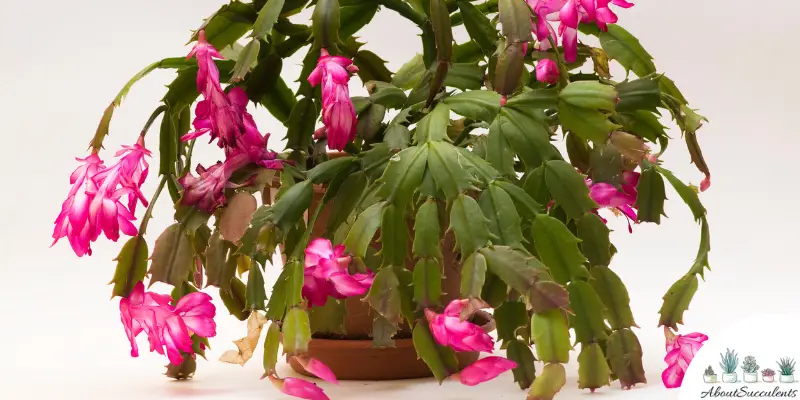
Although Christmas Cactus or Schlumbergera Truncata is named after a winter holiday it is a plant that grows best in tropical regions or areas that average 65-75 degrees Fahrenheit (18 to 23 degrees Celsius).
Perhaps Schlumbergera Truncata is named Christmas Cactus because it bears the grower a present in the wintertime in the form of beautiful flowers that bloom in a variety of colors: Purple, pink, and red.
If your Christmas Cactus is having a hard time blooming, give it a bit more sunlight.
Peanut Cactus
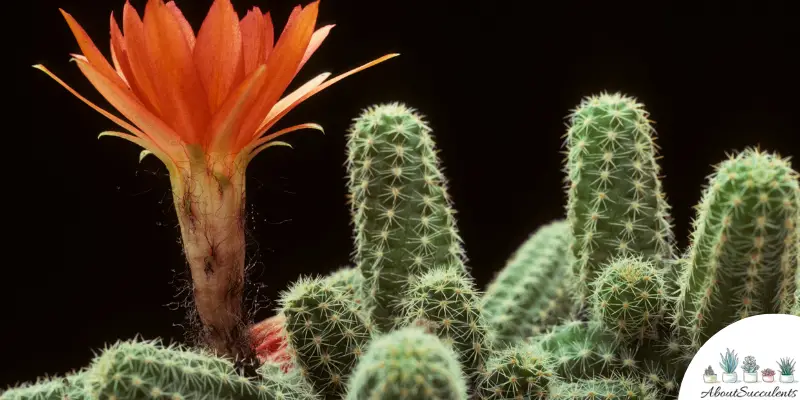
Peanut Cactus or Echinopsis chamaecereus is a succulent plant that is native to Argentina. This succulent grows better in tropical regions and in many cases, it’s advisable to expose the plant to full sun to achieve its full beauty.
During the springtime, Peanut Cactus will produce large flowers with colors that range from bright orange to red-orange. The flowers are beautiful and will tend to cover the cactus clump.
Peanut Cactus is best grown in a garden because this type of succulent grows very quickly and will occupy a considerable amount of space.
Crown of Thorns
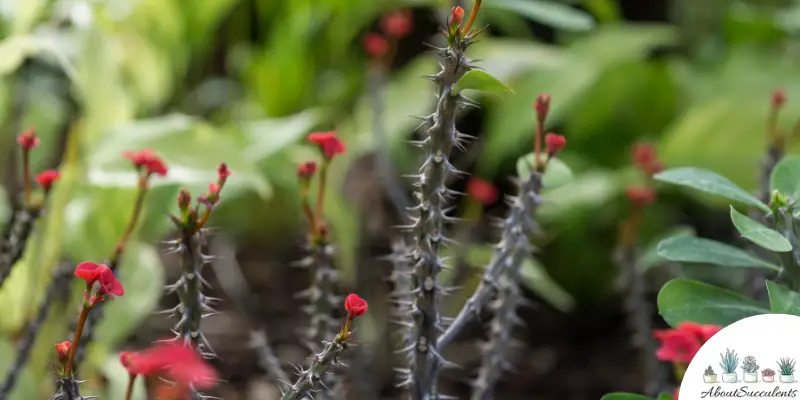
Crown of Thorns or Euphorbia milii is one of the best choices of flowering succulents because it blooms several times a year. This type of succulent is very easy to grow and care for.
You can grow it outdoors even if your region experiences frosty conditions. Crown of Thorns is also ideal as an indoor plant because it easily adapts to changes in temperatures.
Crown of Thorns grows best with temperatures ranging from 65-75 degrees Fahrenheit (18-23 degrees Celsius) but can tolerate temperature drops of 50 degrees Fahrenheit (10 degrees Celsius).
Aloe
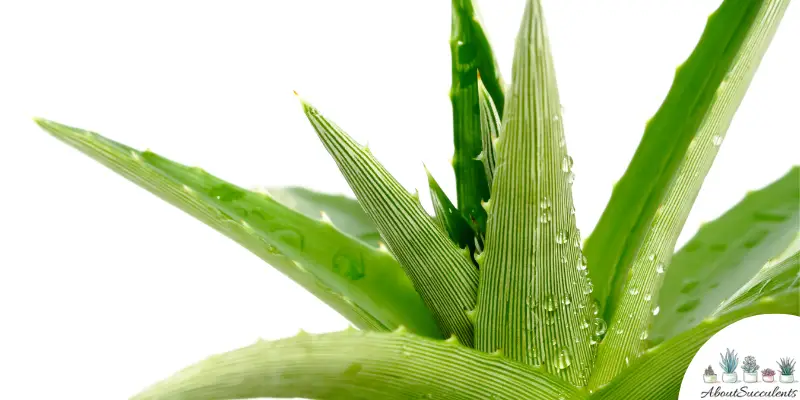
Aloe or Aloe barbadensis is a type of succulent that has been grown for thousands of years because of its medicinal properties. It makes for an excellent addition to the garden or the indoors because the sap can be used to treat skin conditions including cuts and burns.
Aloe produces flowers during the months of March and May. The flowers come up from its inflorescence that rises from a beautiful rosette. The blooms have a tubular shape with yellow and orange colors.
It should be noted that only mature Aloe succulent plants can produce flowers. Your Aloe should at least be 4 years old for it to bloom.
Pincushion Cactus
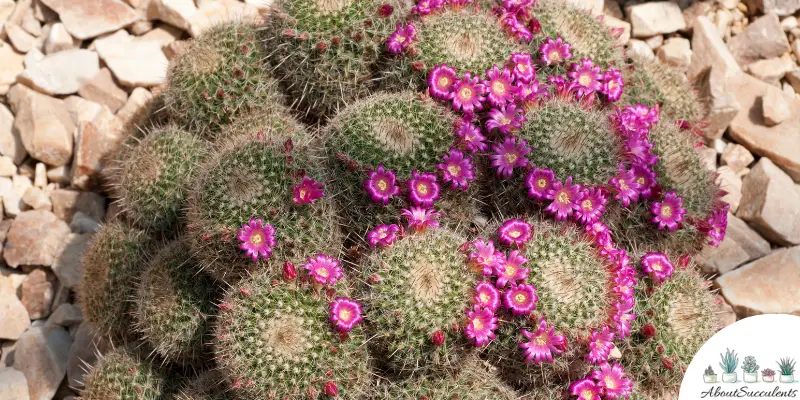
Pincushion Cactus or Mammillaria crinite is a flowering succulent that is can tolerate drought conditions and is very easy to grow and care for. Although it can be grown indoors, it might be better to plant Pincushion Cactus outdoors because it has hooked spines that can harm your children and pets.
For Pincushion Cactus to produce blooms, the succulent plant has to receive at least 4 hours of morning sunlight every day. To get Pincushion Cactus to produce beautiful flowers, hold off the watering schedule for several weeks into springtime.
The flowers of Pincushion Cactus have a funnel shape and appear in a variety of colors – pink, white, green, red, and yellow.
Orchid Cactus
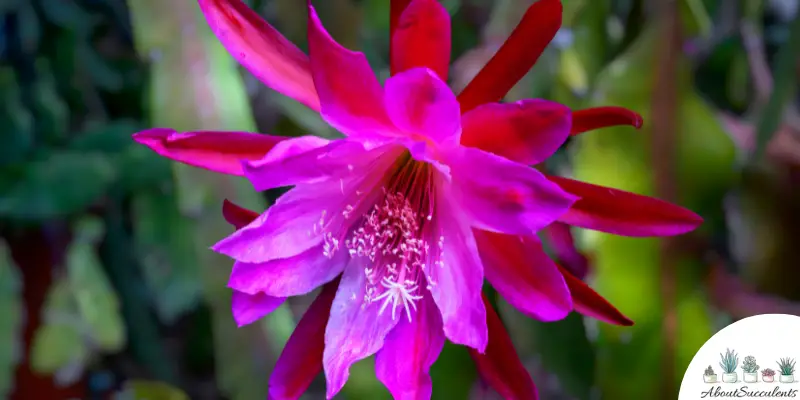
Orchid Cactus or Epiphyllum hybrids grow best in regions under hardiness zones 10 and 11 with temperatures that range 30-40 degrees Fahrenheit (-1.1 to 4.4 degrees Celsius).
Orchid Cactus is a flowering succulent but it does not produce blooms as much as the other varieties on this list. Typically, Orchid Cactus will bloom at night a few times a year. In fact, you might notice that this succulent will not produce flowers during its first 2 years.
Once it blooms, Orchid Cactus will produce large-sized glowers in the springtime and well into the summer season.
Rock Purslane
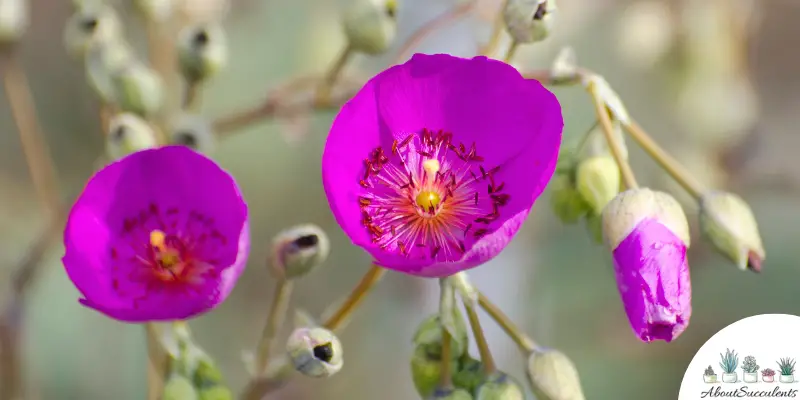
Rock Purslane or Calandrinia spectabilis is a flowering succulent that is native to Chile. If you live in a region where temperatures drop as low as 25 degrees Fahrenheit or -4 degrees Celsius, Rock Purslane is the succulent plant for you!
During the spring until fall, Rock Purslane blooms several flowers that are colored pink and bright purple. The flowers are poppy-like and tend to draw in growth-nurturing insects such as butterflies and bees.
Moon Cactus
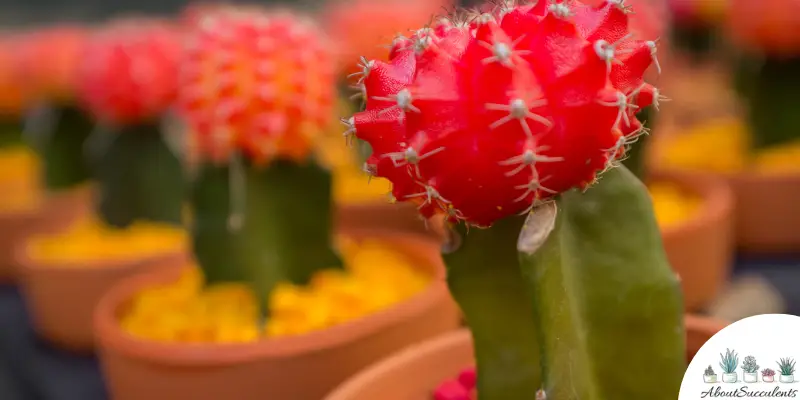
Moon Cactus or Gymnocalycium mihanovichii is native to South America, particularly in Argentina, Brazil, Paraguay, and Bolivia. Horticulturists love to grow Moon Cactus for the tantalizing pink, yellow, and orange flowers that it produces.
If you are thinking of growing Moon Cactus, bear in mind that this type of flowering succulent does not produce chlorophyll. You will have to graft Moon Cactus onto a rootstock that can produce chlorophyll.
Another thing to remember when caring for Moon Cactus is that it is more susceptible to overwatering than other varieties of succulents.
Afterglow
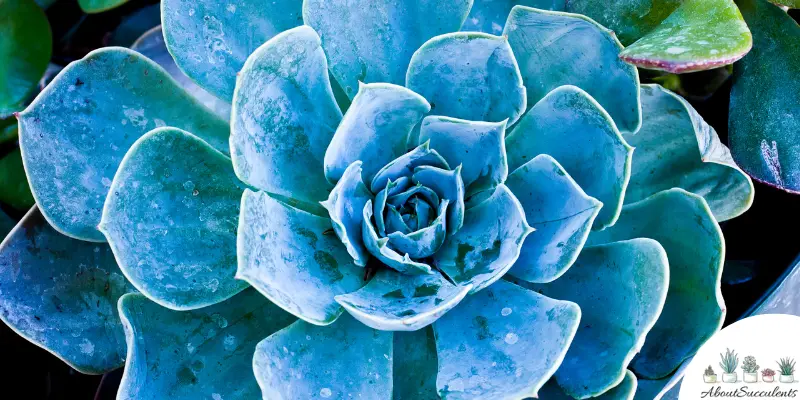
Afterglow or Echeveria Afterglow is native to Mexico and among the varieties of echeverias is widely regarded as having the most beautiful flowers. When Afterglow blooms, you will see cherry red flowers on a rosette that has a shade of lavender.
The leaves of Afterglow exhibit a hue of pink on its outer edges that give the succulent a mesmerizing look.
Afterglow grows best in regions where temperatures don’t go lower than 20 degrees Fahrenheit or -6.7 degrees Celsius.
Flowering Kalanchoe
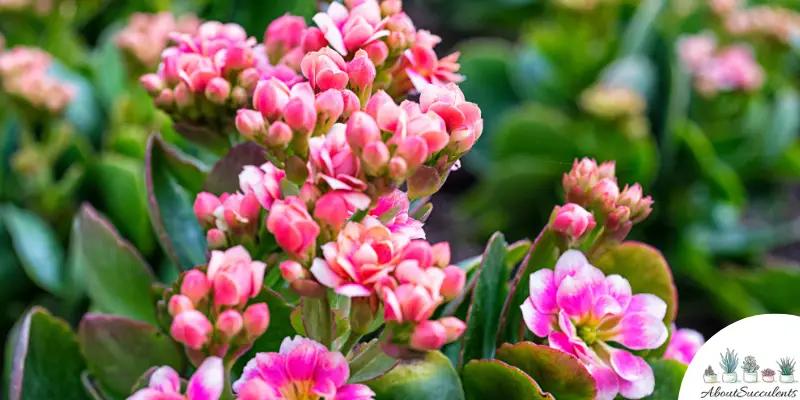
Flowering Kalanchoe or Kalanchoe blossfeldiana produces small clusters of flowers that are pink in color. Set against the backdrop of dark green foliage and the flowers come to life.
For Kalanchoe to produce blooms, it should receive at least 6 hours of sun every day. Inside the house, place the pot near a window that gets at least 3 hours of partial sun every day.
Flowering Kalanchoe is native to Madagascar and is best grown indoors as a houseplant. Be careful of having this type of flowering succulent around pets as it can be toxic for them.
Marble Buttons
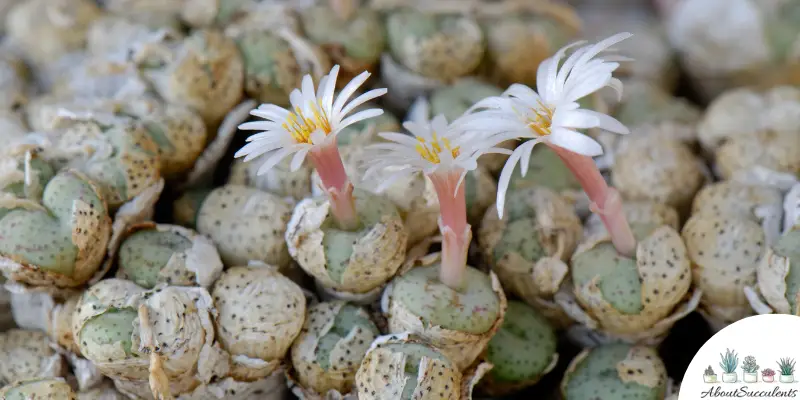
Marble Buttons or Conophytum calculus is beautiful in its own unique way which is why horticulturists include this type of flowering succulent in their must-have-in-the-garden list.
For one, Marble Buttons are shaped like marble; the leaves appear to fuse together to form an interesting hairless spheroid that has a chalky but smooth texture.
In the fall season, Marble Buttons produce flowers that vary in color from yellow to gold to dark-orange and emit a scent similar to clove.
Jade Plant
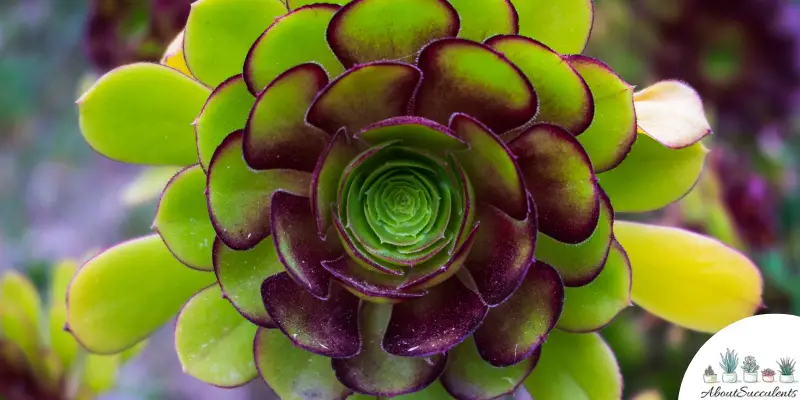
Jade Plant or Crassula ovata is one of the easiest flowering succulents to grow and care for because it is highly tolerant of drought conditions and can withstand frost conditions better than other varieties of succulents.
Jade Plant is native to the Kwazulu-Natal province, the Eastern Cape of South Africa, and Mozambique. It is best grown indoors and produces flowers that are colored pink, purple, and white.
Another feature of Jade Plant that makes it eye-catching is its blue-green foliage with tips that change in color from burgundy to maroon.
To enable Jade Plant to attain its full beauty, you must give it at least 6 hours of sunlight outdoors and if grown indoors, position the plant near a window that gets 3 to 6 hours of partial sunlight every day.
Conclusion
As they say “beauty is in the eyes of the beholder”. Certainly, there are other flowering succulents that might catch your eye.
Just remember to give your succulent plants their daily dose of morning sunlight and to keep track of their watering schedule.
It doesn’t take much time and effort to take care of your succulents. In exchange, you will be rewarded with beautiful flowers that will amaze and impress everyone who sees them.
Last Updated on June 27, 2022 by Sofia Lara